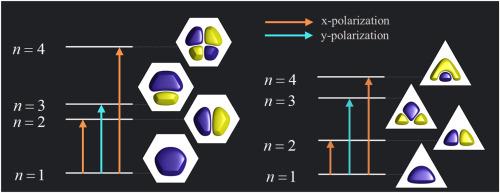Enhanced polarization sensitivity and tunability in truncated pyramidal GaAs quantum dots for FIR applications
IF 8.2
2区 材料科学
Q1 MATERIALS SCIENCE, MULTIDISCIPLINARY
引用次数: 0
Abstract
The far-infrared (FIR) spectrum, covering wavelengths from 20 to 1000 , presents significant challenges for the manipulation and detection of polarized light, especially in the short-wavelength FIR range of 20–100 . This study investigates the effectiveness of truncated pyramidal GaAs quantum dots in improving the absorption coefficient of polarized light within this range. Utilizing the finite difference method to obtain numerical solutions of the Schrödinger equation within the adiabatic approximation, we analyze the effects of various base shapes—equilateral hexagon, irregular hexagon, and equilateral triangle—on the optical absorption coefficients when subjected to an electric field with different directions and magnitudes. Our results reveal that triangular pyramidal quantum dots offer enhanced polarization sensitivity and greater tunability of absorption peaks compared to structures with other base shapes. Moreover, the direction of the applied electric field is crucial for tuning the absorption peaks in the desired range of FIR wavelength. These findings demonstrate the potential of truncated pyramidal GaAs quantum dots not only for improving sensing technologies but also for managing electromagnetic interference in advanced communication systems.

增强截顶金字塔砷化镓量子点的偏振灵敏度和可调谐性,实现 FIR 应用
远红外线(FIR)光谱的波长从 20 微米到 1000 微米不等,这给偏振光的操纵和探测带来了重大挑战,尤其是在 20-100 微米的短波长 FIR 范围内。本研究探讨了截顶金字塔砷化镓量子点在改善该范围内偏振光吸收系数方面的有效性。利用有限差分法在绝热近似条件下获得薛定谔方程的数值解,我们分析了不同基底形状(四边形六角形、不规则六角形和等边三角形)在不同方向和大小的电场作用下对光吸收系数的影响。研究结果表明,与其他基底形状的结构相比,三角形金字塔量子点具有更高的偏振灵敏度和更强的吸收峰可调性。此外,外加电场的方向对于在所需的红外波长范围内调节吸收峰至关重要。这些研究结果表明,截顶金字塔砷化镓量子点不仅具有改进传感技术的潜力,还具有管理先进通信系统中电磁干扰的潜力。
本文章由计算机程序翻译,如有差异,请以英文原文为准。
求助全文
约1分钟内获得全文
求助全文
来源期刊

Materials Today Nano
Multiple-
CiteScore
11.30
自引率
3.90%
发文量
130
审稿时长
31 days
期刊介绍:
Materials Today Nano is a multidisciplinary journal dedicated to nanoscience and nanotechnology. The journal aims to showcase the latest advances in nanoscience and provide a platform for discussing new concepts and applications. With rigorous peer review, rapid decisions, and high visibility, Materials Today Nano offers authors the opportunity to publish comprehensive articles, short communications, and reviews on a wide range of topics in nanoscience. The editors welcome comprehensive articles, short communications and reviews on topics including but not limited to:
Nanoscale synthesis and assembly
Nanoscale characterization
Nanoscale fabrication
Nanoelectronics and molecular electronics
Nanomedicine
Nanomechanics
Nanosensors
Nanophotonics
Nanocomposites
 求助内容:
求助内容: 应助结果提醒方式:
应助结果提醒方式:


